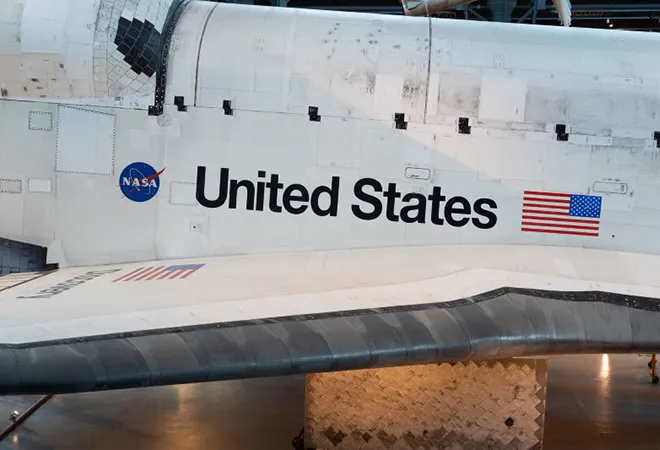
The newly inaugurated Biden administration following a tumultuous transition has introduced a new space policy. The administration’s space policy announced, if not an anaemic but a modest military thrust. Biden has parted ways from his predecessor Donald Trump on several fronts as far as space policy goes. Most critically, Biden’s space policy departs from Trump by embracing investment in space science and technology to fight climate change, which Trump emphatically rejected and never considered it a challenge, let alone a priority. Biden’s space policy would consist of studying how climate change drives extreme weather and surging sea-levels. The Artemis Lunar Exploration Programme is unlikely to become a casualty under Biden despite being initiated by Trump. The lunar mission seeks to land the first woman and the first man on the Moon as well as establish a presence of the South Pole on the Moon. It will be called the Artemis Base Camp. While Biden is unlikely to pursue a wholescale jettisoning of Trump’s space policy; however, the timelines are likely to shift for the Artemis Lunar Exploration Programme from 2024, which was an ambitious target in any case, to possibly 2030. Regardless, the US’s return to the Moon would be a shot in the arm for space exploration and would serve as a stepping stone for a deep space exploration.
Biden’s space policy departs from Trump by embracing investment in space science and technology to fight climate change, which Trump emphatically rejected and never considered it a challenge, let alone a priority.
However, on the military side of the Biden administration’s space policy, there is a real risk of the Trump administration’s launch of a US Space Force (USSF) suffering significant diminution, if not getting the axe. Trump’s establishment of a space force was a significant departure from previous administrations and promised to deliver new technologies, operational capacities, and doctrine and strategy for space operations and missions. All these tasks, when taken together are very ambitious to be realised in the short to medium term. However, as Bleddyn Bowen acutely points out, beyond caricaturing the US Space Force, there have to be substantive reasons for objecting to its establishment. The Biden administration White House Press Secretary, Jen Psaki, did almost exactly that: “Wow. Space Force. It’s the plane of today,” comparing it in a somewhat snarky way to earlier questions regarding the new colours for the presidential jet — Air Force One. Representative Michael Waltz, a Republican who was equally scathing in his response: “This is just another example of the administration not taking China seriously while demeaning the incredible work of Space Force personnel.” After all militaries, as Bowen reinforced, have to think about warfighting and equally every domain and environment in which wars are fought.
The more interesting element is whether the USSF remains resilient enough to meet the demanding visionary tests of US policy managers, especially the one unveiled under the Air Force Space Command (AFSC) in October 2019. There is an emerging debate within the US over whether to build a space equivalent of Blue Water naval force or a Brown Water naval force. In the case of the former, the operational domain would extend the US Space Force significantly beyond low-Earth orbit and right up to the Moon and beyond. The American objective is ensuring no state can dominate the lunar poles, or more generally the lunar surface. Thus, the cislunar space extends between the Earth and just beyond the lunar orbit and the five Lagrangian Points that “are stable positions in reference” to between the Moon and Earth as they rotate. In a nutshell, when centrifugal forces in equal measure from the Sun and the Earth and the Earth and Moon (as shown in Figure -1), L1 is in front of the Moon and L2 is behind separated from each other by about 60,000 kilometers. They also exist between the Earth and the Sun (as shown in Figure 2), which also shows five different Lagrange points. However, in the case of the two Sun-Earth Lagrangian points: they are located 1 million miles each from the Earth and the Sun. The Lagrangian points are critical because they can hold large objects such as space stations. Take for instance in the Sun-Earth Lagrangian point of L1, the Solar and Heliospheric Observatory (SOHO) is present and the Deep Space Climate Observatory is at L2. There are three additional Lagrange points, but science is yet to discover what L-3 might be relevant for. In the case of L4 and L5, which are deemed highly stable and where asteroids and other celestial accumulate can serve as an in-space or in-orbit colony, because of their closeness to the Earth. Similarly, in the case of the Earth-Moon L1 and L2, which are the most critical Lagrange points with zero gravity where a space station can easily locate because it is stable and vehicles transporting supplies or conducting missions do not require landing gear. Energy depots could also be located at L1 and L2.
The American objective is ensuring no state can dominate the lunar poles, or more generally the lunar surface.
Figure 1 — Earth-Moon System
 Source: The Space Option
Source: The Space Option
Figure 2 — Earth-Sun System
 Source: NASA/WMAP Science Team
Source: NASA/WMAP Science Team
The Lagrangian points between the Earth and Moon and Earth and Sun are very vital for other reasons as well — national security and defence, therefore, the US would not want any competitor to dominate. However, today one key contender is there — the Peoples Republic of China (PRC). Beijing has a very ambitious space programme to exploit the Lagrange points to their advantage. The five Lagrange points in each of the dyads, Earth-Moon and Earth-Sun, are very important because they allow movement of spacecraft or objects from point to another with the least cost to energy. Dominating the Earth-Moon Lagrangian points means that the anti-satellite system could take the proverbial “high ground.” In the case of the five Lagrangian points in Earth-Sun dyad, the purpose for an advanced space faring such as the United States of America (USA) would be to dominate operations within the inner solar system. The discussion and debate about the military importance of the Lagrangian points within the American space strategic community is not unique or assumed significance recently, they occurred during the Cold War. Between the end of the Cold War and today, technological and scientific breakthroughs and progress and the emergence of the PRC have created military opportunities and dangers. Indeed, the establishment of the USSF provides partial confirmation and testifies to it and the USSF is geared to preventing any peer competitor, which evidently is the PRC to access the Lagrange points in the Earth-Sun and Earth-Moon in a manner detrimental to the USA and other space faring countries. Whether the PRC can achieve some form of control definitively at this stage is unclear, but if the Biden administration underestimates the drive and space military ambitions of the PRC, it would be a monumental folly because the competition with the US is underway.
The views expressed above belong to the author(s). ORF research and analyses now available on Telegram! Click here to access our curated content — blogs, longforms and interviews.




 Source:
Source:  Source: NASA/WMAP Science Team
Source: NASA/WMAP Science Team PREV
PREV


